A visit to Suriname
The broccoli with a spicy sauce
After 9 hours of flying, the plane starts to descend. The plane dives under the down blanket of clouds and from my window I see endless greenery. The dark green of treetops, as we get closer to the airport Zanderij, is alternated with the poisonous green and brown of the lands and lots. Furthermore I see, the bauxite-rich soil, red coloured roads as carelessly left behind ribbons through the landscape.
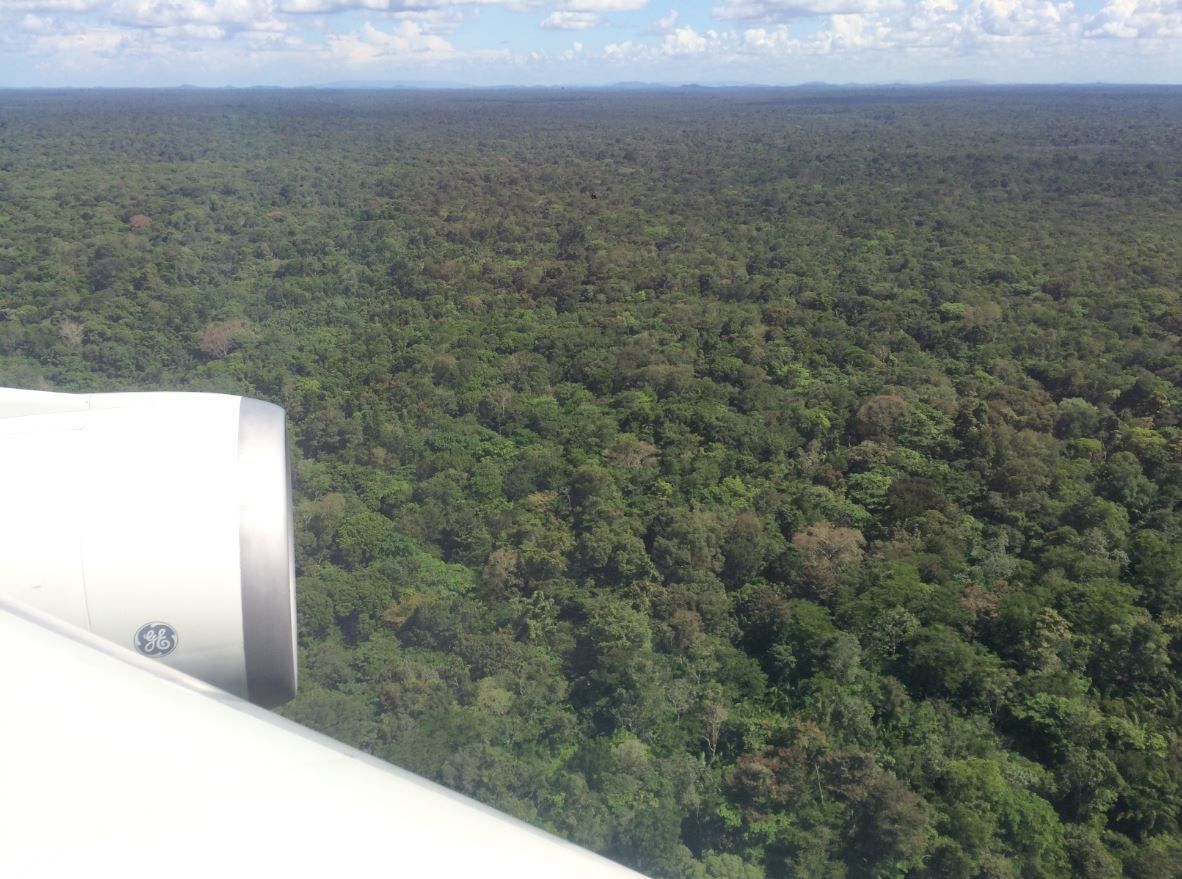
Our start in Suriname
After arrival, the tropical warmth welcomes me, like an hug, which won't let go of me for some time to come. As we approach Paramaribo, the traffic gets busier. The road network hasn't grown with the number of cars yet. Closer to the city centre we see the first mosque fraternally next to a church. This statue, sometimes accompanied by a Synagogue, is typical for Suriname. The centre of the capital has the, for me recognizable, raw sweltering hustle and bustle of a tropical South American provincial town, where historical buildings give a glimpse of the colonial era.
A trip through Suriname can best be started in Paramaribo with a walk through the historic centre with a good guide. In this way the eventful history of the country comes more to life and the different historical buildings get more meaning. We start our walk at the Cabinet of the President, where 'Mama Sranan', the primeval mother of Suriname and her five children, proudly looks down on you from above.
'Mama Sranan', the mother of Suriname
This symbol, a statue of a mother with five children, stands in front of the president's cabinet. The five children represent the various population groups with different origins, which make Suriname's culture so colourful and multifaceted:
- The indigenous population, those who populated the American continent long before the arrival of the Europeans;
- The Creoles, the descendants of the slaves from Western Africa;
- The Hindus and Javanese;
- The descendants of contract workers from the British and Dutch East Indies
- The Chinese;
- The Europeans, the descendants of the colonizers from the Netherlands, the British kingdom, the French and Portuguese.
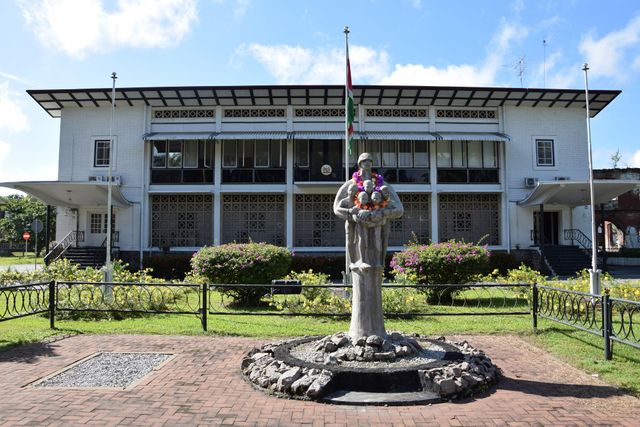
All of them came, voluntarily or not, to this watery green piece of land on the north side of South America and together they further coloured the colourful culture of Suriname. In few places in South America you can find such a mix of ethnicity, which can be found in the spoken languages and dialects, the buildings and of course the local cuisine. In Suriname the worship of the Kankantrie, or kapok tree, is a special example of this symbiosis of different cultures. This majestic forest giant came to Suriname because slaves from West Africa smuggled the seeds of this tree with them. Nowadays you see this tree throughout the country and it is seen as a sacred tree by every culture, not just by descendants of West Africans.
To get a 'literal' taste of the different cultures, you can visit the central market or restaurant De Gadri, on the waterfront just behind the National Asemblee. Another must is 'De Waag', not only because of the food, but also because it is a beautiful historic building. Our last evening in Paramaribo we visited 'Miroso', one of the many warungs in the Javanese Blauwgrond district. The food was delicious and for a moment we imagined ourselves in Asia ;-)
From Paramaribo to the Amazon
After a few days in Paramaribo it was time to see more of this special South American country. A country that counts as the smallest independent South-American country, but more than 4 times as big as the Netherlands. Less than 500,000 people live in Suriname. No less than 250,000 people live in Paramaribo and that means that the rest of the country is almost devoid of people. We noticed this when we flew with a small plane from the domestic airport Zorg en Hoop to Kabalebo, deep in the Amazon of Suriname.
In an hour we flew to a small runway somewhere in the dense and untouched jungle of Suriname, far from civilization. After we had left the city of Paramaribo behind us, all we saw below us were trees. A gigantic broccoli, over which we flew like a tiny mosquito. Nowhere a village, nowhere a house, nowhere a plume of smoke that could indicate any kind of human presence. The runway at Kabalebo was constructed in the 1950s as part of 'Operation Grasshopper'. The then Minister of Construction, Frank Essed, conceived 'Operation Grasshopper', in which a total of 7 runways were constructed in the (extreme) inland of Suriname, in order to open up this inland and to make it possible to map the natural resources present here. At that time bauxite was discovered and mined, but with the military coup in 1980 and the drop in the price of Bauxite came the drawback. “Operation Grasshopper" stopped, but the runways were there.

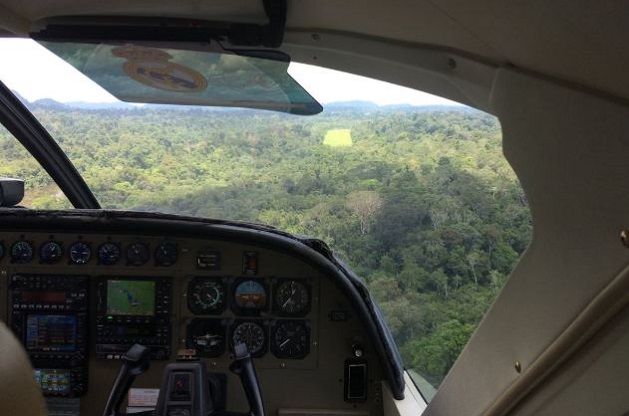
Spending the night at Kabalebo, very special!
At Kabalebo the houses of defence and workers have been replaced by a nice lodge with outbuildings. By the way, the meteorological post of that time is still in use. At that time there were no people living in this region and that is still the case. The nearest community lives about 300 kilometres away, which means 2 to 3 weeks sailing in a small boat. Try to imagine; you are staying with about 30 other travellers in an impenetrable jungle area as large as the Netherlands. You and those 30 others are the only representatives of the human species, while you are surrounded by countless plant and animal species in the most diverse manifestations. Very special!
With this awareness, it is perhaps the superlative to realize that they have been able to create a beautiful lodge here, where you can stay in all comfort. A place where you can relax and swing in your hammock, while you see monkeys playing in the trees near the runway. A place where a tapir is quietly looking for fruit and at the same time a swarm of brightly coloured macaws flies over it with a lot of noise. This is the setting of Kabalebo.
On a voyage of discovery
A calm came over me and at the same time the enthusiasm bubbled up in me and I wanted to explore this fantastic environment. After arrival and after lunch we made our first short walk in the area directly behind the buildings of Kabalebo. Iwan, our indigenous guide, introduced us to 'the woods', as the Surinamese call the rainforest. By nightfall the first boat trip in a small boat awaited us and we witnessed the exuberant wild life of the rainforest that has never been hunted in the area.
We saw swarms of macaws that stood out against the evening red, toucans watching us high up in the trees and kingfishers flying low over the water. Between the branches of a treetop we saw a sloth and in the bushes on the shore a large group of squirrel monkeys playing while some Capuchin monkeys were annoyed watching them. This first boat trip turned out to be the prelude to the explosion of wild life that we saw during our stay. On one of the evenings there was a lecture about the history of Kabalebo. We were also told that 'Lotje', the Ocelot (a feline), visited the lodge regularly. What we didn't know at the time was that we would see her ourselves later that night.
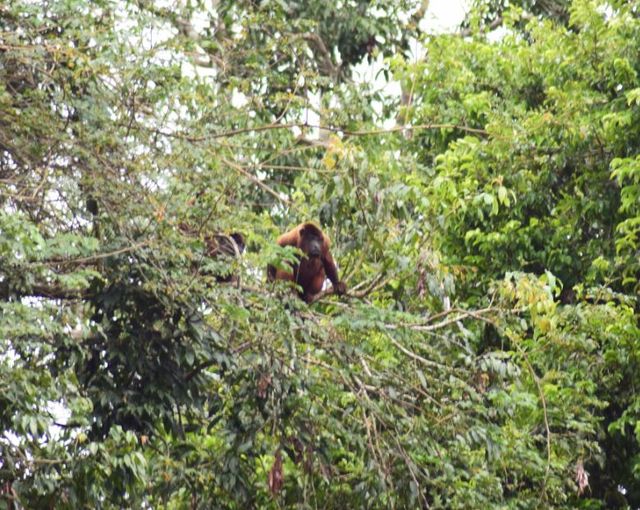
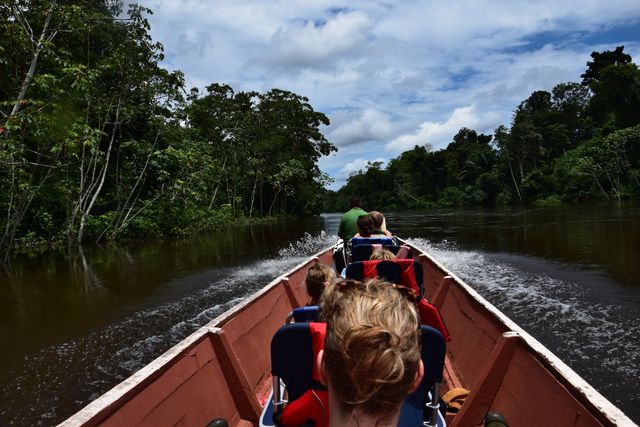
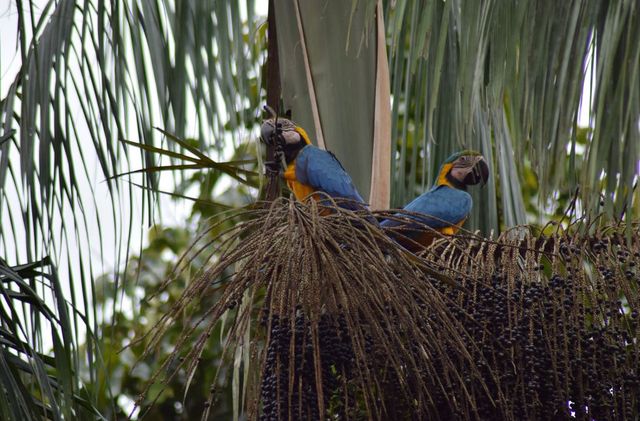
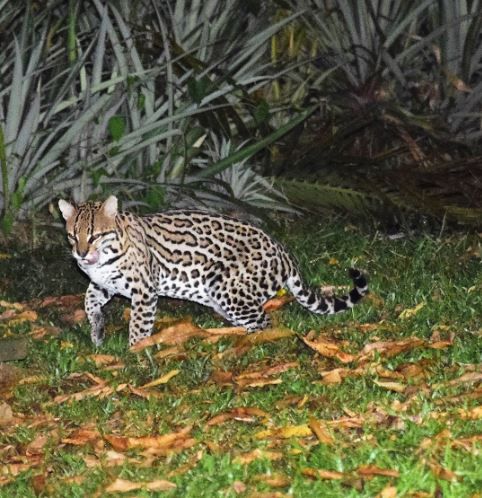
Kabalebo with children
We visited Kabalebo at the beginning of August, at the end of the rainy season and the water level was high. How much wild life do you get to see when the water level is low and all the animals go to the rivers? Also for Emma, our daughter of 12 years old, staying at Kabalebo was a very nice experience. Not only the fact that she was in a very special location in the middle of nature, but also the fact that she could talk with the guide about the animals and his experiences in 'the woods' in her own language. Unfortunately, after 4 days our stay at Kabalebo came to an end and we flew back to civilization.
One day later we drove from Paramaribo, over the Jules Wijdenbosch bridge over the Suriname river, to the district Commewijne. Commewijne is the district of the sugar plantations and to get a good picture of the Surinamese past a visit to this district is a must. Many historical plantations are overgrown and taken back by tropical nature. Fortunately, several initiatives have been launched in recent years to restore some of the plantations to their former glory. We visited plantation Concordia near Stolkertsijver, which is completely overgrown by rainforest. For the time being, there are no plans to restore this plantation to its former glory. After mooring with the small boat, we walk for about 3 minutes in the rainforest and suddenly we see the remains of what was once a sugar cane press in the middle of the wilderness. It is hard for us to imagine that this rugged piece of 'forest' was a thriving plantation in the 18th and 19th centuries.

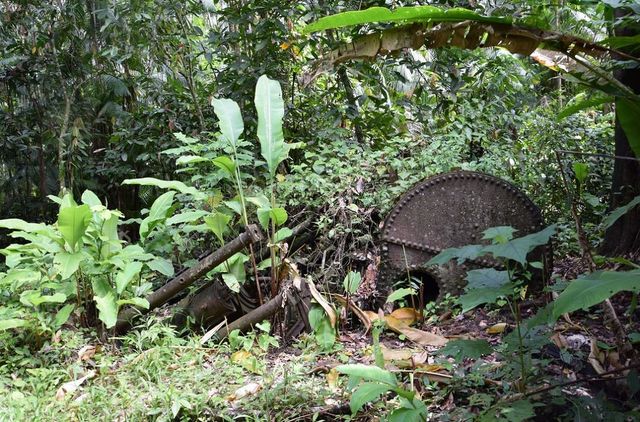
A guided tour by Monsieur Soekardi at Mariënburg
At Mariënburg we meet Mr. Tukijan Soekardi. Mr. Soekardi grew up near Mariënburg and worked there as a worker until the factory closed down in 1986. The plantation was founded in 1745 and was at one time considered the most important trade and production centre of the sugar industry in Suriname. Once many hundreds of people lived and worked here and now we could see that since closing in the eighties nature was slowly but surely regaining ground.
As we walked through the ruins of the sugar factory and listened to Mr. Soekardi's stories, our thoughts wandered to times long gone; how busy it must have been here, hard work and little rest in a scorching tropical heat. After slavery was abolished in 1863, first the Chinese and later the Hindus and Javanese from the former British and Dutch East Indies were brought to Suriname. Although they were contract workers, they hardly had it better than the Creole slaves. In the month of July of the year 1902 this led to an uprising in which 24 people were killed and 32 wounded. One hundred years later, Ramdien Sardjoe, the then vice-president of Surinam, unveiled a monument in memory of the fallen of this uprising. In addition to this monument there is also a monument in memory of the Javanese immigration on Mariënburg.
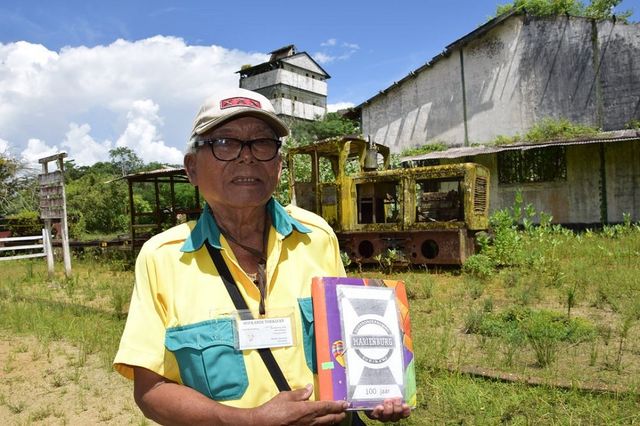

A stopover at Fredriksdorp
We continue our trip by small boat and after crossing the Commewijne river, we visit Plantation Fredriksdorp. Frederiksdorp is a former coffee and cocoa plantation from the 18th century by the German Johann Friedrich Knöffel. This plantation is one of the first plantations which was restored or, as the Surinamese themselves so beautifully say, 'rehabilitated'. Now Frederiksdorp is a beautiful location as part of a day trip or where you can spend the night. There is a restaurant and a swimming pool and if you choose to stay overnight, you can sleep in the former police house or commandant's house. You can also stay 'on stand' in the plantation house (perfect for families!), where even the original coffee drying floor can still be found.
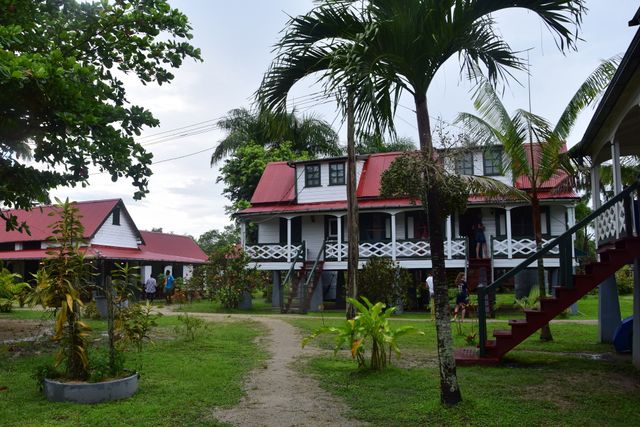
An introduction to the Sotalia dolphin
After a short introduction to this plantation, we board our small boat again for a special closing of this beautiful day. From Frederiksdorp we sail to the place where the Commewijne river meets the Suriname river, with Fort Amsterdam at the land point in between. Here lives a special species of dolphin; the Sotalia, popularly known as the pink belly tumbler. It is estimated that about 400 specimens of this rare dolphin species live in this area. Our boatswain, with his small boat 'Fritsje', has been in a working group studying these dolphins for 12 years. With some nice music on, we're going. A little further on we meet another small boat. As we approach them, people are gesturing to us that our boatswain has to turn off the music. Our boatswain chuckles once and then tells us that the other boatswain hasn't been spotting the dolphins for very long. He tells us that the dolphins like the music. Well, this is right! He has only just finished his story and suddenly we see dozens of dolphins around our boat. The other small boat sails meekly, at an appropriate distance, after 'Fritsje'. In a breath taking setting, where the beautiful evening red of the setting sun gives the water almost the same colour as the belly of the dolphins, we experience an unforgettable spectacle. Emma shouts; "this is the most beautiful thing I have ever experienced" and even though the sun had set, Emma doesn't want to leave.


The Upper Suriname River and Marron culture
The next day the introduction to the Upper Suriname River and the Marron culture present here is on the program. Marron comes from the Spanish word Chimarrón. This word was used by the conquerors for the cattle that ran off to the mountains on the island of Hispañola. Turned into Marron, this became the nickname for the slaves who had fled from the plantations. Many slaves then fled to the banks of the Upper Suriname and Saramacca rivers. They founded settlements on the river, often close to so-called 'sula's' (rapids). Soldiers, sent from colonial rule to bring back slaves who had fled, had to get out of the boat at these rapids to pull their boats over the rapids and at that moment they were easy to rob. The Marron culture still has many customs and traditions of the slaves from West Africa, their motherland. Saramaccan, the language of the Maroons, is named after the Saramacca River. In addition to the same strong West African influence, this language also has influences from the Portuguese, English and Dutch languages. Our guide and driver take us, via a beautiful paved road, to the town of Atjoni. The road stops here and in the river the small boats are ready for the continuation of our route.
The river is the only link between the Marron villages and the rest of Suriname. First we sail to the Anaula lodge, half an hour from Atjoni. Upon arrival lunch is ready for us and in the afternoon we go with 2 guides and some other guests from the lodge to a nearby sula. Here we can have a nice swim, which is nice after such a long sit from Paramaribo. The fast flowing water compliments the whole with a lovely massage, what more could we want. After nightfall, we go up the river again to spot caimans, but unfortunately they don't want to show up. We were able to spot the eyes, but as soon as we get closer, they quickly dive under the water. At the end of the rainy season, the chance of spotting caimans is small because of the high water level.

The next day we are picked up at the Anaula lodge and sail upstream for another hour and a half (in this period!). It strikes me that we are now sailing deeper into the forest. The number of passing small boats decreases and we can also measure it by the decrease in litter (sin!) we encounter along the way. We get further and further away from civilization and we only pass some smaller Marron villages. We see children playing on the waterfront and people washing themselves and/or their clothes in the river. We enjoy ourselves and after a beautiful small boat trip we finally arrive at the Danpaati lodge.
A wonderful stay at the Danpaati lodge
Exuberantly we are welcomed by Christa, the manager of Danpaati, and some employees. Danpaati is a unique lodge, situated on an island in the river, not far from the village of Dan. The lodge is run by the local community and the proceeds of the lodge go to the same community. Meanwhile the lodge contributes to a home care project in 12 surrounding villages and by now there are already three crèches, so girls in particular no longer have to look after their little brothers and/or sisters and can go to school by themselves. Danpaati is like a warm blanket. The Danpaati employees clearly have a lot of love and passion for their culture and environment. They love to share this with you and it feels very hospitable. We enjoy and learn from it.
In the afternoon we take a guided walk through the village of Dan. We are spontaneously accompanied by some children from the village. Emma plays with them while our guide tells us about the Marron culture. If you want to learn more about the Marron culture, it is advisable to visit the nearby village of Pikin Slee. Here is a Marron museum and here you can see the traditional houses in which people live inside. In the evening we had dinner at tables in the beautiful garden, beautifully lit with torches. Unfortunately we're only here for one night, we would have liked to have stayed even longer.
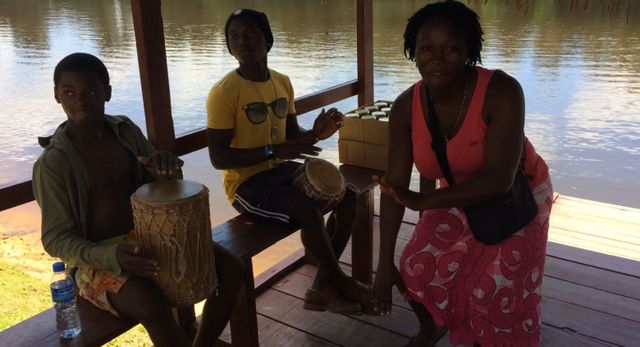


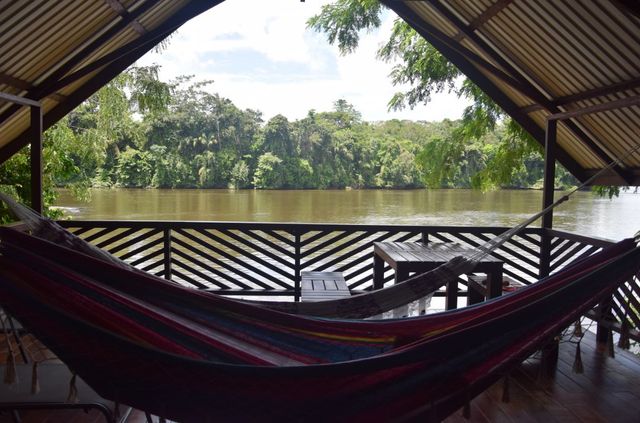
Our last night in Suriname
After a good night's sleep and after a good breakfast we continue our journey. Early in the evening we arrive at Berg en Dal and very early the next morning our flight to Aruba is planned. So we can't really enjoy the facilities that Berg en Dal has to offer us. However, that night's bartender makes up for everything. That he didn't miss his calling, that's obvious. Instead of an extensive dinner we choose for a (small) snack on the terrace near the bar. What a good choice with such a nice bartender, who seems to have invented hospitality. What a nice evening, what a wonderful ending to this beautiful country and its warm population.
Suriname is beautiful and has a lot to offer. Whether you like nature, culture, good food, adventure, history or just a little bit of everything, this is a country you really should visit!
Tip: Combine Suriname with Aruba
Beautiful beaches you unfortunately do not have in Suriname, but with only 2 hours flight you are already on Aruba. A nice addition to a versatile and adventurous trip through Suriname.

Travel through Suriname?
Did this story make you curious about Suriname and would you like to know more about it? Then take a look at the travel itineraries of Suriname that we have put together for inspiration. You can book these trips directly, but we are also happy to create a personal programme based on your wishes and ideas.
Do you have a direct question? Please feel free to contact us. Call +31 73 610 62 04 or send an email to info@sapapanatravel.nl. We are happy to help.